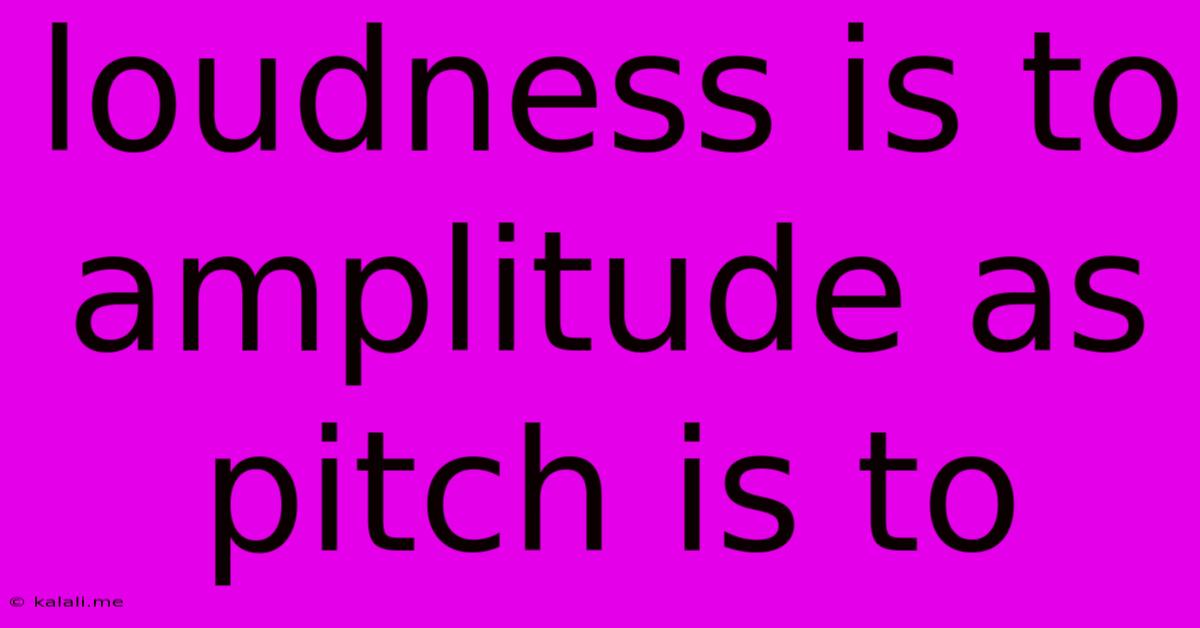Loudness Is To Amplitude As Pitch Is To
Kalali
Jun 14, 2025 · 3 min read

Table of Contents
Loudness is to Amplitude as Pitch is to Frequency: Understanding Sound Waves
Meta Description: Learn the relationship between loudness and amplitude, and pitch and frequency in sound waves. This article explains the key characteristics of sound and how they relate to our perception of audio.
Sound is a fundamental aspect of our world, yet understanding its characteristics can be surprisingly complex. We often describe sounds based on their loudness and pitch. But what are the underlying physical properties that determine these perceived qualities? The answer lies in understanding the relationship between loudness and amplitude, and pitch and frequency.
Understanding Amplitude and Loudness
Amplitude refers to the maximum displacement of a sound wave from its equilibrium position. Imagine a wave; the amplitude is the height of that wave. A larger amplitude means a greater displacement, resulting in a more powerful wave. This directly translates to loudness. A larger amplitude corresponds to a louder sound, while a smaller amplitude equates to a softer sound. We measure amplitude in units like Pascals (Pa) or decibels (dB). Think of hitting a drum softly versus hitting it hard – the harder hit results in a larger amplitude and therefore a louder sound.
Understanding Frequency and Pitch
Frequency, on the other hand, refers to the rate at which a sound wave vibrates or oscillates. It's measured in Hertz (Hz), representing the number of cycles per second. A higher frequency means more vibrations per second, leading to a higher pitch. A lower frequency results in fewer vibrations and a lower pitch. Think of a high-pitched whistle versus the low rumble of a bass drum. The whistle has a much higher frequency.
The human ear can typically perceive sounds ranging from about 20 Hz to 20,000 Hz. Sounds below 20 Hz are infrasound and those above 20,000 Hz are ultrasound, both inaudible to most people. Variations in sensitivity exist across the population, and hearing capacity decreases with age.
The Interplay of Amplitude and Frequency
While amplitude and frequency are distinct properties, they both contribute to our overall perception of sound. A loud sound can be high-pitched or low-pitched, and similarly, a soft sound can also be either high or low in pitch. Therefore, a complete description of a sound requires both its amplitude (loudness) and its frequency (pitch). This allows us to precisely differentiate between various sounds in our environment.
Analogies and Examples
To further clarify the relationship, consider these examples:
-
Loudness/Amplitude: Think of a speaker’s volume control. Turning up the volume increases the amplitude of the sound waves produced, resulting in a louder sound.
-
Pitch/Frequency: Imagine playing a piano. Each key corresponds to a different frequency, generating a different pitch. Striking the same key harder will increase the amplitude (loudness) but won't change the frequency (pitch).
Conclusion: A Complete Acoustic Picture
Understanding the relationship between loudness and amplitude, and pitch and frequency is crucial for comprehending the fundamental nature of sound. While we perceive sound holistically, it’s the interplay of these underlying physical properties that allows us to distinguish between the quiet chirping of a cricket and the powerful roar of a lion, or the delicate notes of a flute and the deep tones of a cello. This knowledge provides a clearer, more complete understanding of the acoustic world around us.
Latest Posts
Latest Posts
-
Electric Field Inside A Non Conducting Sphere
Jun 15, 2025
-
A Transformer Is A Device Used To
Jun 15, 2025
-
A Celestial Body That Revolves Around A Planet
Jun 15, 2025
-
The Push Or Pull On An Object Is Called
Jun 15, 2025
-
How Many Sig Figs In 500
Jun 15, 2025
Related Post
Thank you for visiting our website which covers about Loudness Is To Amplitude As Pitch Is To . We hope the information provided has been useful to you. Feel free to contact us if you have any questions or need further assistance. See you next time and don't miss to bookmark.